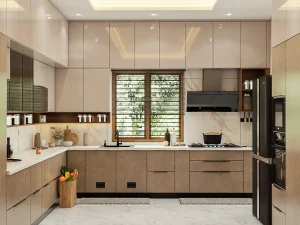
Kitchens take a lot of abuse, so the floor you choose for it is important. Spilled food, dropped pans, and muddy footprints are inevitable in this space, so make sure the flooring can handle it.
Engineered wood is top for no expansion or contraction with temperature or moisture changes while looking great.
Durability
Food debris, spilled utensils, lots of walking and extreme temperatures are what kitchen floors need to survive – so choose one that will stand up to the test!
It’s also important in high traffic areas and if your family has kids or pets who frequently make messes. Vinyl and luxury vinyl tile (LVT/LVP) are popular options for durability. These come in different colors, patterns and textures with waterproof versions available to protect from spills or splashes.
Travertine natural stone tile provides superior durability as well as a look most home buyers appreciate – good for your property’s value! Hardwood is another favorite; although not technically “waterproof” some brands offer rigid core versions so standing on them doesn’t hurt your feet over long periods of time.
Style
Solid hardwood floors are elegant choices for classic kitchen designs because they resist moisture and have many decor options. They also work well under moderate traffic loads and can be refinished multiple times throughout their life.
Engineered wood flooring is a great alternative if solid hardwood is out of reach. It’s moisture resistant like its solid counterpart but comes in many styles, finishes and colors too!
Tile looks beautiful as always with great durability and easy maintenance – plus it’s versatile enough to resemble wood, stone, or concrete appearances.
Cork flooring offers soft cushiony feet underfoot which may pique your interest but also comes at a cost: its own specific appearance that might restrict your interior design aesthetics. Unfortunately cork does not hold up well against moisture buildup nor does it get grippy when wet – two cons you want in a kitchen floor.
Maintenance
Make sure your kitchen floor can handle your kitchen! This is important for both its durability and the way it complements its design.
Concrete floors are super durable and can be stained to look like wood or tile while still being eco-friendly, but they’re hard on your feet if you stand on them for long periods of time.
Linoleum is another option that’s reliable and easy to maintain. It doesn’t need waterproof coating to resist water and food spills well. Vinyl offers a similar level of durability at an economical price plus it feels soft underfoot.
Budget
Homeowners generally have a budget in mind when shopping for their kitchens, so make sure you’re helping them find the right flooring by asking them what that range is! They want a floor with great style but they also want it at a good price.
Once upon a time, concrete floors were only seen in industrial settings. But now they’re the talk of the town for trendy kitchens that need that extra bit of flair and style. You can even stain them to look like wood, stone or tiles.
But all that style comes at a cost, literally — and we’re not talking about your wallet. Concrete is dangerously slippery so make sure you put mats under any concrete surfaces to avoid any slip disasters.
Sheet vinyl is another budget friendly option that has been upgraded for today’s trends. And for those looking to put their home on the market in the future, solid hardwoods are a great choice because they can be refinished. Just keep in mind professional installation services will have to be hired if you go with this option.
Cork is soft underfoot and eco-friendly but doesn’t provide as high of a return on investment as hardwood or engineered wood options do.






